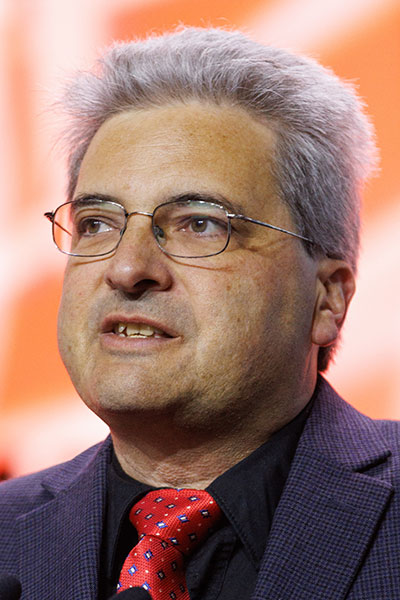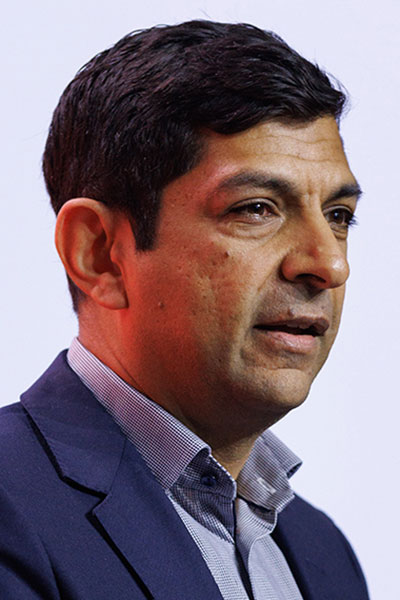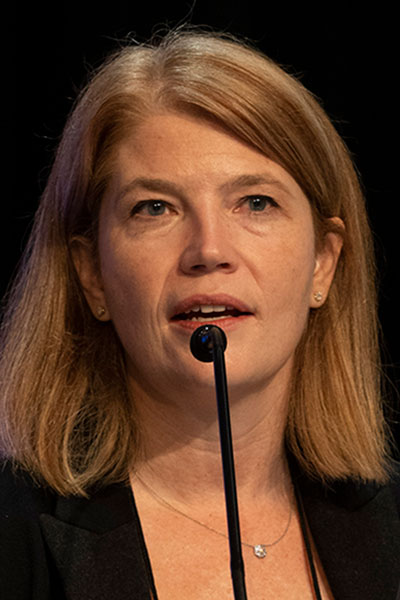The past year has brought practice-changing insights and advances across the spectrum of breast cancer research and clinical practice. SABCS 2022 concluded on Saturday, December, 10, with the annual Year in Review session where a panel of experts offered four snapshots of the most important developments across the field.

Basic science
Andrei Goga, MD, PhD, Professor of Cell and Tissue Biology and Co-Leader of the Breast Oncology Program, University of California San Francisco Helen Diller Family Comprehensive Cancer Center, explored new findings in the basic science of breast cancer subtypes, technologies, immune oncology, and metastasis.
“We have heard a lot of talk about CDK4/6 inhibitor resistance and ways we might overcome it at this meeting,” Dr. Goga said. “Unfortunately, the majority of patients will gain resistance at some point in their treatment journey.”
Two strategies to overcome CDK4/6i resistance have emerged. One begins with the recognition that there are multiple cyclin dependent kinases. Dinaciclib, which inhibits CDK1/2/4/9, can overcome resistance to CDK4/6 + aromatase inhibition and other CDK inhibitors may be developed.
And CDK4/6 is not a unique target. The spindle assembly checkpoint kinase TTK and mitotic kinases Aurora A/B play key roles in cell cycle progression. All are vulnerable to inhibition in ER+ breast cancers that have become resistant to CDK4/6i.
HER2 breast cancers are notable for their heterogeneity, which can allow some tumors to escape treatment. The antibody-drug conjugate trastuzumab deruxtecan (T-Dx) offers an improved bystander effect that can effectively treat heterogeneous HER2 tumors and HER2-low tumors. Active investigations are attempting to tease out whether the increased effectiveness of T-Dx is due to the antibody, linker, payload, or some combination of the three components.
“Triple negative breast cancer remains a major clinical problem,” Dr. Goga noted. “It may be possible to encourage TNBC to differentiate into something that is more targetable or less aggressive.”
Polo-like kinase (PLK) plays a role in cell mitosis, he continued, and preclinical studies show that PLK inhibition can differentiate TNBC and decrease tumor aggressiveness. Tumors treated with PLKi show increased DNA damage, growth arrest, and cell death.
There has also been progress in personalized tumor screening platforms. Patient-derived xenografts and organoids can be tested in high-throughput screens, though clinical impact has yet to be demonstrated. For the 70% of breast cancers that cannot be successfully propagated using xenografts, patient-derived explants that retain ER characteristics may be useful.
On the technology side, new approaches could identify synergistic drug combinations. High-content imaging, better known as Cell Painting, can identify 1,500 distinct cell features that can be compared to existing compound libraries and gene perturbation datasets to identify new drug candidates.
New mechanisms of tumor cell immune evasion are suggesting new targets. Immunotherapy can induce transient cell-in-cell conjugates that protect tumor cells within other tumor cells from T-cell activity. Quiescent cancer cells resist T-cell attack by forming clusters that exclude immune infiltrates, and MYC oncogene overexpression in TNBC may promote immune evasion.
There are also important findings in the metabolism of metastasis. Metastatic TNBC tumors are a hybrid, combining metastatic features of the primary tumor as well as the tissue site of metastasis. And skeletal muscle generally escapes metastasis due to high levels of oxidative stress. Intratumoral bacteria and fungi appear to play active roles in metastasis, and release of circulating tumor cells is higher at night than during the day. Circadian rhythm hormones that regulate rest-phase disseminated tumor cells may be useful.
“We still can’t cure most of our patients with metastases,” Dr. Goga said, “But we are getting better at understanding some of the mechanisms at work.”

Translational research
Shom Goel, MBBS, Associate Professor in The Sir Peter Maccallum Department of Oncology, University of Melbourne, Australia, reviewed 2022 advances in translational science, beginning with biomarkers.
“There is a divide between the promise of next-generation sequencing developing new biomarkers and the reality of clinical practice,” Dr. Goel said. “The reality is that finding an alteration we think is targetable is not the norm for our patients. We have to do better.”
The prognostic value of any single clinical, genomic, pathological, and treatment response feature is always in question, he continued. But machine learning and other approaches make it possible, perhaps practical, to combine multiple features to improve predictive values and scores.
Data from I-SPY2 show that reclassifying breast cancers by response-predictive subtypes rather than the familiar receptor subtypes can dramatically improve prediction. So can combing multi-omic classifiers.
And for the first time, there are good data supporting biological differences in breast cancers based on race or ancestry, not just on social disparities. Comparing TNBC profiles from patients in the United States with African ancestry and TNBC patients from Ghana and Ethiopia identified genetic variants associated with East African, West African, and mixed populations.
“This is the first study to link gene expression variations across an international cohort with altered tumor biology and different clinical outcomes,” Dr. Goel said. “We have to think not just about social disparities when we see racial disparities in breast cancer outcomes, but biological differences that may be in play.”
Several recent papers focus on the impact of ESR1 mutations on tumor behavior. ESR1 mutant breast cancers show differences in basal genes, metastasis, drug response prognosis, and tumor clonality. Mouse models can be particularly helpful in understanding this distinct biology.
The CDK4/6i resistance story is also evolving. All roads lead to the G1/S checkpoint, Dr. Goel noted, which suggests new targets are waiting to be identified. The challenge is reinitiating cell cycle regulation after CDK4/6 resistance develops.
“TNBC remains one of the most challenging subtypes,” Dr. Goel continued. “Platinum response is different in mutated tumors vs. methylated tumors. Exposure to platinum reverses BRCA methylation.”
A key development is the use of preclinical models to explore toxicity profiles, not just clinical activity. Mouse models identified one mechanism by which checkpoint inhibition can impact fertility through follicle loss. A second study identified a specific subset of T cells that can drive immunotherapy-related myocarditis.

Early breast cancer
Marleen Kok, MD, PhD, Medical Oncologist and Group Leader in Biology and Immunology at the Netherlands Cancer Institute, Amsterdam, Netherlands, reviewed developments in early breast cancer.
“Our goals are to cure breast cancer, maintain toxicity, and preserve long-term quality of life at an affordable cost,” Dr. Kok said. “We can only spend a dollar once.”
The KEYNOTE-522 trial of neoadjuvant pembrolizumab + chemotherapy vs. placebo-chemo followed by pembrolizumab vs. placebo in TNBC raised nearly as many questions as it answered, Dr. Kok said. Neoadjuvant pembrolizumab was clearly superior for pathologic complete response (pCR), but there was no significant difference in patient-reported outcomes except fatigue, which was higher in the pembrolizumab arm.
KN522 also excluded dose-dense anthracyclines, adjuvant olaparib, and adjuvant capecitabine, all of which have shown important clinical benefits in other trials.
“We need to put the data into perspective,” Dr. Kok said. “You have to consider the treatments that are not given in a trial. And we have to ask about the added value of adjuvant pembrolizumab. We have trials showing excellent outcomes without it.”
Nor does KN552 show which patients might benefit from the regimen. Multiple trials show clear benefits from chemotherapy without immunotherapy as well as from immunotherapy alone. And there are clear data showing that some patients do extremely well out to at least 15 years without any systemic treatment.
“We should be able to predict treatment response up front,” Dr. Kok said. “Today, we start patients on something, wait a few months to see how they are doing, then try something else. That is not elegant medicine. We need biomarkers and we need to start experimental regimens such as antibody-drug conjugates up front.”
There is still no sign of immunotherapy benefit in early HER2+ breast cancer, she added. And the WSG-ADAPT HER2+/HR- trial showed a 90% pCR for a triple combination of trastuzumab/pertuzumab/paclitaxel with no significant difference in 5-year invasive disease-free survival with or without adjuvant chemotherapy.
In ER+ disease, aromatase inhibition is no better than tamoxifen. AI shows lower risk of recurrence but there is no difference in overall survival. The ASTRRA study showed a benefit for ovarian suppression in premenopausal women, but more than half of patients were not completely suppressed. And MammaPrint data reveal a subgroup of ultra-low risk patients who fared similarly well with or without systemic treatment.
The news is less hopeful on lobular breast cancer.
“In 2022, there are still no trials specifically for lobular cancer,” Dr. Kok said. “That should change.”
The CANTO trial identified four subsets of chemotherapy patients based on quality of life. Some patients had excellent or very good QoL that persisted over 4 years, some had very good QoL that deteriorated, and some had poor quality of life. Risk factors for deteriorating or poor QoL include young age at diagnosis, obesity, smoking, low income, comorbidities, and endocrine treatment.
And while cancer surgeons and radiation oncologists have successfully deescalated and personalized treatment without reducing outcomes, medical oncologists have not made similar gains.
“We need to select patients better and more actively for de-escalation,” Dr. Kok said. “We need to follow the lead of our surgical and radiation colleagues and stop trials for ‘all-comers.’ I envision trials only for targeted populations and biomarker-driven outcomes with value-based pricing based on efficacy + toxicity. Otherwise, there are too many drugs to select appropriately.”

Advanced breast cancer
Melinda Telli, MD, Associate Professor of Medicine at Stanford University School of Medicine and Director of the Breast Cancer Program at the Stanford Cancer Institute, discussed changes in advanced breast cancer.
“2022 has been a blockbuster year for antibody-drug conjugates,” Dr. Telli said. “Data we have seen in the last year support use in all significant subtypes of breast cancer.”
New endocrine-based therapies are hopeful, including the AKT inhibitor capivasertib added to endocrine therapy and oral SERDS (selective estrogen receptor degraders).
There have also been disappointments. PALOMA-2 showed no improvement in overall survival from adding palbociclib to first-line letrozole in HR+/HER2- metastatic breast cancer. And NRG-BR002 found no improvement in outcomes from radiotherapy or surgical ablation of metastases in oligometastatic breast cancer.
Multiple trials of CDK4/6 have been reported since SABCS 2021. All three approved agents show similar early benefit, but there are differences in longer term outcomes.
“A big question has been which CDK4/6 inhibitor to choose in the first line,” Dr. Telli said. “Unfortunately we don’t have a head-to-head comparison.”
Ribociclib showed a survival benefit and abemaciclib is likely to show benefit with longer follow up.
Interim results of MONARCH 3, abemaciclib + aromatase inhibitor vs. placebo + AI, showed a strong trend for benefit for abemaciclib with a hazard ratio of 0.75, but the data are immature and the current results are not statistically significant.
Dr. Telli noted that the potential benefits of results of palbociclib are less clear. The interpretation of PALOMA-2 is limited by the large and disproportionate percentage of patients with missing survival data between treatment arms.
“I look forward to all the advances we are going to see in 2023,” she concluded.



